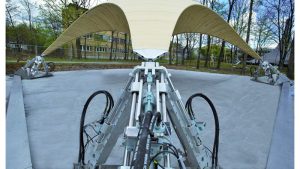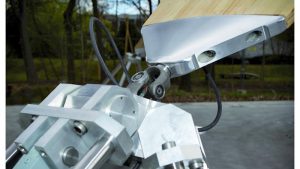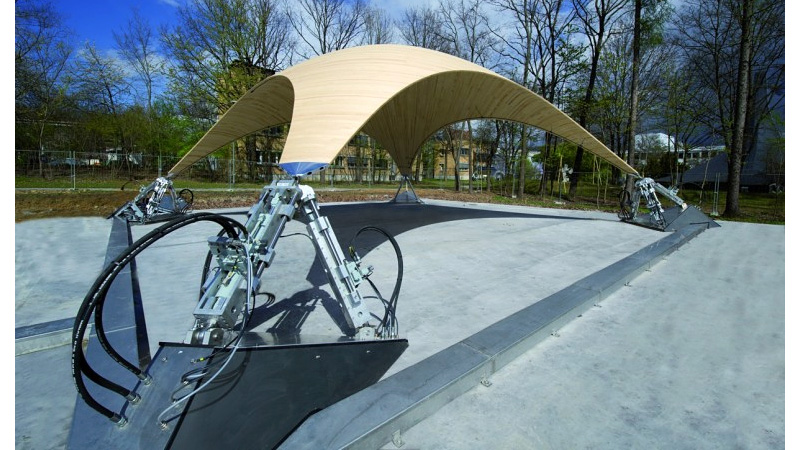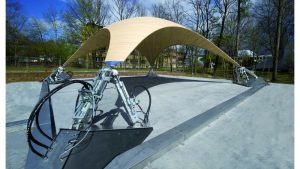 Institute for Lightweight Structures and Conceptual Design (ILEK) and Institute for System Dynamics (ISYS) of the University of Stuttgart in cooperation with Bosch Rexroth have realised an adaptive structure on a large scale for the first time. The shell made of wood is supported at four points. Three of these points can be moved individually by hydraulic cylinders and freely positioned in space. Sensors record the load status at numerous points on the structure. Targeted movements of the points of support counteract variable loads (for example through snow or wind) and thus reduce deformations and material stresses. Compared to conventional, passive structures this considerably reduces the use of materials for the shell. The load balancing takes place through a Rexroth control system which was especially developed for hydraulic drives. The core task of the control system is to implement the complex hydraulic control tasks of the shell structure. In this way the supporting structure can react to a change in the load status within milliseconds.
Institute for Lightweight Structures and Conceptual Design (ILEK) and Institute for System Dynamics (ISYS) of the University of Stuttgart in cooperation with Bosch Rexroth have realised an adaptive structure on a large scale for the first time. The shell made of wood is supported at four points. Three of these points can be moved individually by hydraulic cylinders and freely positioned in space. Sensors record the load status at numerous points on the structure. Targeted movements of the points of support counteract variable loads (for example through snow or wind) and thus reduce deformations and material stresses. Compared to conventional, passive structures this considerably reduces the use of materials for the shell. The load balancing takes place through a Rexroth control system which was especially developed for hydraulic drives. The core task of the control system is to implement the complex hydraulic control tasks of the shell structure. In this way the supporting structure can react to a change in the load status within milliseconds.An active vibration dampening and the adaptation to changing loads can be applied in many areas of construction, for example in stadium roofs, in high-rise buildings, in wide-spanning façade constructions or in bridges. The results of the research project at the University of Stuttgart thus enable a completely new construction method which not only saves resources but at the same time also considerably increases the performance of supporting structures. The active dampening of dynamic loads (for example from the effects of wind, earthquake or explosions) namely enables not only a drastic reduction in weight but furthermore also reduces material fatigue and damage to the structure. In order to be able to actively compensate loads and vibrations, these influencing factors initially have to be precisely recorded resp. predicted; a second step would be to calculate the necessary counter-movements in real time (and likewise promptly to implement them). Researchers from the University of Stuttgart developed simulation models for this purpose, enabling an exact prediction of the behaviour of the structure. The material stress as well as the vibration behaviour under static and dynamic exposure is thereby taken into account. These simulation models serve as a basis for the development of control concepts which calculate the necessary counter movements on load and vibration compensation depending on the recorded measured values. These movements are then precisely implemented through the hydraulics.
In order to be able to actively compensate loads and vibrations, these influencing factors initially have to be precisely recorded resp. predicted; a second step would be to calculate the necessary counter-movements in real time (and likewise promptly to implement them). Researchers from the University of Stuttgart developed simulation models for this purpose, enabling an exact prediction of the behaviour of the structure. The material stress as well as the vibration behaviour under static and dynamic exposure is thereby taken into account. These simulation models serve as a basis for the development of control concepts which calculate the necessary counter movements on load and vibration compensation depending on the recorded measured values. These movements are then precisely implemented through the hydraulics.
Read more about it Here and Here
Project participants:
Institute for Lightweight Structures and Conceptual Design (ILEK), University of Stuttgart
Prof. Werner Sobek, Stefan Neuhäuser, Christoph Witte, Dr. Walter Haase
Institute for System Dynamics (ISYS), University of Stuttgart
Prof. Oliver Sawodny, Martin Weickgenannt, Dr. Eckhard Arnold
Bosch Rexroth AG, Lohr a. Main
Dr. Johannes Grobe, André Fella
Contacts:
Stefan Neuhäuser: Tel.: 0711 685-63705,
Martin Weickgenannt: Tel.: 0711 685-66960,
André Fella: Tel.: 09352 18-1010,



